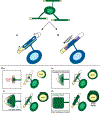Dynamics and mechanisms of CNS myelination
- PMID: 25710531
- PMCID: PMC6715306
- DOI: 10.1016/j.devcel.2015.01.016
Dynamics and mechanisms of CNS myelination
Abstract
Vertebrate myelination is an evolutionary advancement essential for motor, sensory, and higher-order cognitive function. CNS myelin, a multilamellar differentiation of the oligodendrocyte plasma membrane, ensheaths axons to facilitate electrical conduction. Myelination is one of the most pivotal cell-cell interactions for normal brain development, involving extensive information exchange between differentiating oligodendrocytes and axons. The molecular mechanisms of myelination are discussed, along with new perspectives on oligodendrocyte plasticity and myelin remodeling of the developing and adult CNS.
Copyright © 2015 Elsevier Inc. All rights reserved.
Figures




References
-
- Allen NJ, and Barres BA (2009). Neuroscience: Glia - more than just brain glue. Nature 457, 675–677. - PubMed
Publication types
MeSH terms
Grants and funding
LinkOut - more resources
Full Text Sources
Other Literature Sources

